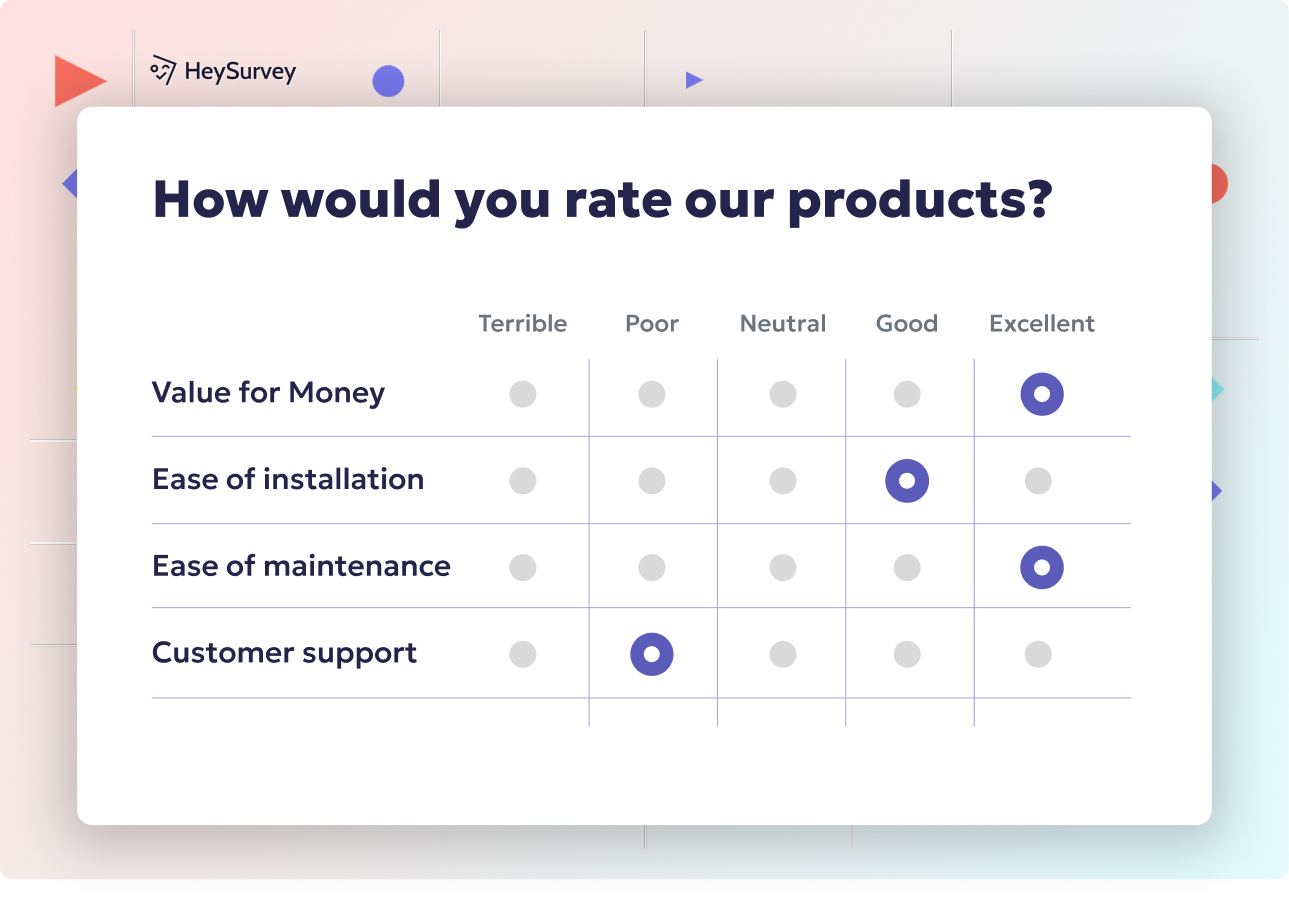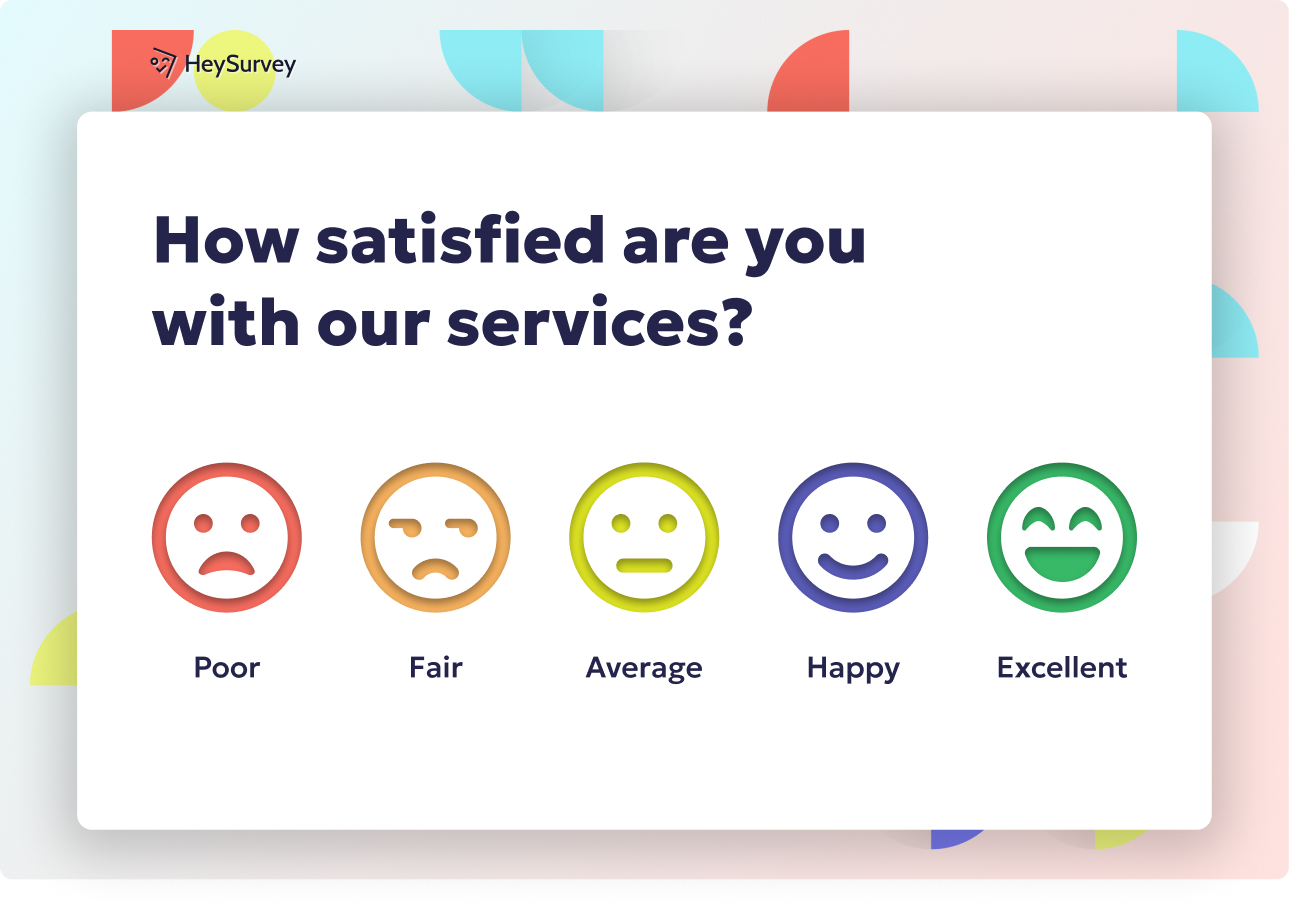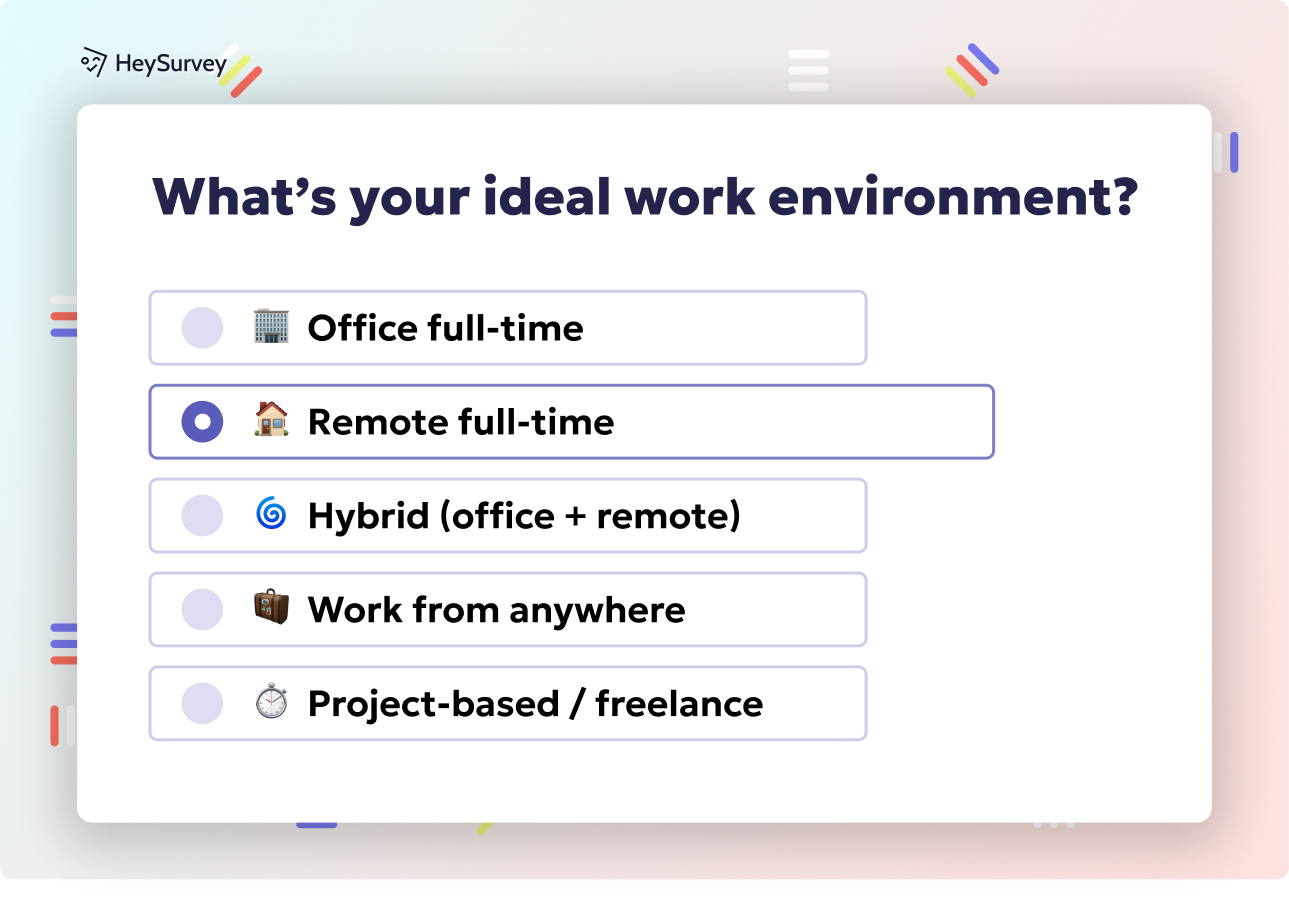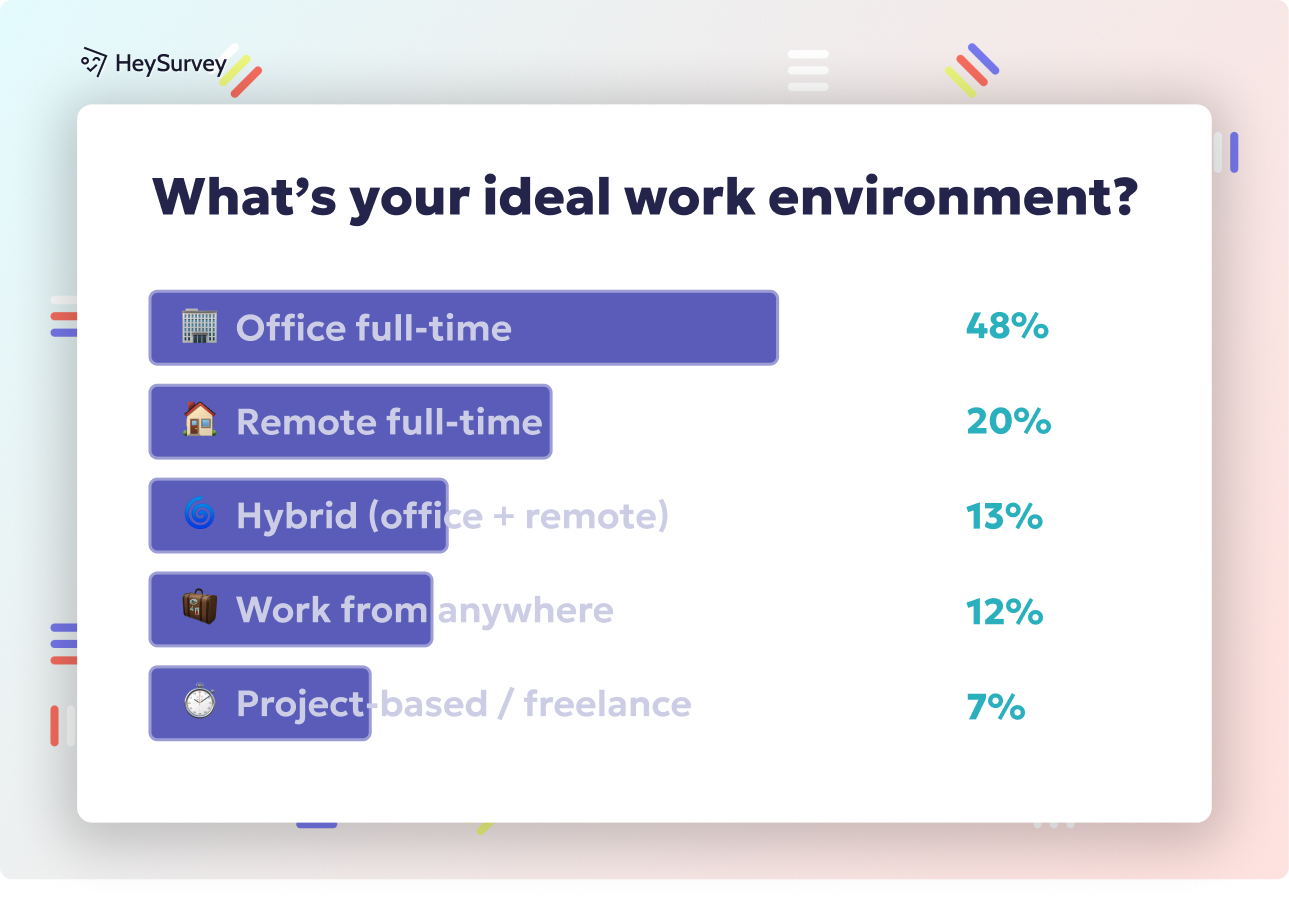31 Gaming Survey Questions: Ultimate Guide to Know Your Players
Discover 30+ expert gaming survey questions covering player demographics, gameplay, monetization, esports, and more for valuable player insights.
Gaming surveys are the secret sauce that powers today’s most-loved titles and hardware. Whether you’re a giant studio, feisty indie developer, hardware manufacturer, or an esports organization, these questionnaires serve up invaluable “player feedback” and “game development insights.” They help untangle “player sentiment analysis” during pre-launch, post-patch balancing, ongoing live-ops, or while tinkering in your R&D lab. Knowing exactly what to ask and when means surfacing issues before they turn into headaches, maximizing engagement, and creating games that players love and return to again and again.
Player Demographic Surveys
Why & When to Use This Survey Type
Gamer demographics are the backbone of player persona research. These surveys shine brightest when you need to validate who’s really playing your game versus who you think is playing it. You can deploy them before greenlighting a project, ahead of user acquisition campaigns, or as part of routine pulse-checks after a massive update or when launching on new platforms.
Want to check if your new expansion pulled in teen gamers from Europe? Track shifts in player base with crisp demographic surveys. Adjust marketing messages, send region-friendly push notifications, or tailor in-game events by knowing your audience to the letter. That way, you never waste resources targeting the wrong age group or region.
Studios that do regular player persona research spot trends and changes before rivals do. After a content drop, you might realize your audience is suddenly a little older, or perhaps a surprise influx from a new region means translating chats or menus actually matters now. Surfacing this intel helps pivot everything from storylines to store pricing.
5+ Sample Questions
- Which age bracket do you fall into?
- How would you describe your gender identity?
- In which country/region do you currently reside?
- How many hours per week do you typically spend gaming?
- What other genres do you frequently play besides this game?
Break down the walls between you and your players, and you’ll create virtual worlds where everyone feels included, seen, and hyped for what’s next!
A 2021 study by the Entertainment Software Association found that 55% of U.S. gamers are male and 45% are female, with 73% identifying as white, 9% Hispanic, 8% Black, and 6% Asian. (axios.com)

How to Create Your Gaming Survey with HeySurvey in 3 Easy Steps
Ready to dive into collecting player feedback using HeySurvey? Don’t worry if you’re new here—we’ve made it super simple to get started.
Step 1: Create a New Survey
- Head over to HeySurvey and click “Create Survey.”
- Choose either an empty survey, a pre-built template, or start typing questions directly.
- Give your survey an internal name so you know what it’s about (like “Gameplay Feedback Q2” or “Monetization Survey”).
Step 2: Add Your Questions
- Click “Add Question” at the top or between existing questions.
- Pick the question type—single choice, multiple choice, scale ratings, text input, etc.
- Enter your question text, add descriptions if you want, and mark questions as required if they must be answered.
- You can attach images or emojis to keep things lively and customize your choices.
- Use branching if you want certain questions to appear based on previous answers (more on that below).
Step 3: Publish Your Survey
- Preview your survey to make sure it flows well and looks good on mobile and desktop.
- When you’re happy, hit the “Publish” button.
- You’ll get a shareable link to send to your players or embed into your website.
- Remember, you’ll need a free HeySurvey account to access responses once they start rolling in.
Bonus Tips: Make Your Survey Shine and Work Smarter
Apply Branding
- Upload your logo and customize colors, fonts, and backgrounds from the Designer Sidebar.
- A branded survey feels professional and builds trust with your players.
Define Settings
- Set start and end dates for when the survey is active.
- Limit the number of responses if needed, or redirect players to a special thank-you page when they finish.
- Allow players to see aggregated results if you want to keep the community looped in.
Use Branching to Personalize Experience
- Set specific questions to appear only if certain answers are chosen.
- For example, ask monetization questions only to paying players, or skip competitive play items for casual gamers.
- This cuts down on survey fatigue and yields more relevant data.
Now you’re all set to create a nimble, engaging survey that captures meaningful player insights. When you’re ready, click the button below to open a tailored HeySurvey template and get started!
Gameplay Experience Surveys
Why & When to Use This Survey Type
Gameplay feedback surveys are the beating heart of continuous improvement. Deploy them during closed betas, public test realms, or anytime you shake up the core experience with a patch or expansion. If you want true “player experience questions” that matter, focus on what really happens when a gamer picks up the controller or taps that mobile screen.
Studios use these insights to unearth friction points in tutorials, aha moments with new features, or sudden confusion when the difficulty spikes just a little too much. These surveys help you benchmark player satisfaction using classic metrics like CSAT or NPS—perfect for tracking how every new patch lands.
You can zero in on everything from first-time user experience to long-term engagement. Was your new stealth system easy to understand? Is the UI cluttered? Better to ask than guess—game development insights gathered here make sure fun doesn’t get buried under bugs or bad UX.
5+ Sample Questions
- On a scale of 1–10, how enjoyable was your most recent play session?
- Which in-game feature felt most intuitive to you?
- Where did you experience frustration or confusion?
- How challenging did you find the current difficulty setting?
- Would you recommend this game to a friend? Why or why not?
Frequent, focused feedback turns an average session into an epic adventure—and gives your team a crystal ball for what’s up next.
Effective in-game surveys should be concise, relevant, and timed appropriately to maximize player engagement and yield actionable feedback. (gamespublisher.com)
Monetization & Pricing Surveys
Why & When to Use This Survey Type
Game pricing surveys and IAP feedback are your safety net before new cash shop missteps. Studios drop these surveys before they roll out downloadable content (DLC), battle passes, or flashy cosmetics. Gauging willingness to pay before new monetization helps avoid those notorious Reddit meltdowns.
Take a deep dive: what do your players think is a “fair” price for skins? How much would they really pay for a season expansion? Use these insights to craft irresistible bundles and dynamic pricing models that maximize revenue without nicking trust or sparking outrage.
You can even spot purchase blockers early on. If a new player drops your game after seeing pricey microtransactions, or if longtime fans bristle at “pay to win” whispers, a smart survey brings this to light before it’s headline news. That’s player sentiment analysis with a direct impact on your studio’s bottom line.
5+ Sample Questions
- How likely are you to purchase cosmetic items priced at $4.99?
- Which payment model do you prefer: one-time purchase, season pass, or free-to-play with micro-transactions?
- What price point feels fair for a premium expansion?
- Which in-game items provide the best value for money?
- Have you ever stopped playing a game due to its monetization approach?
Ask before you launch, adjust before there’s backlash, and watch goodwill (and sales) soar.
Community & Social Interaction Surveys
Why & When to Use This Survey Type
The health of your gaming community is just as vital as killer combat systems or photorealistic worlds. Deploy these “gaming community surveys” regularly, especially after launching guild tools, major chat integrations, or new collaborative modes.
You’ll instantly get a read on whether your guild/clan mechanics spark real connections or if toxicity is starting to bubble. Social surveys let you fine-tune upcoming features like voice chat, group finders, or even custom emojis for more in-game fun. The right prompts lure out honest takes, not just the loudest complaints.
Staying on top of player social interactions boosts retention and loyalty. If players say they’re staying because their guild feels like family, double down on it! If issues like harassment creep in, surface them fast—and act. This way your game’s social fabric remains inviting, safe, and vibrant.
5+ Sample Questions
- How often do you interact with other players in-game?
- Rate your satisfaction with the current chat/voice tools.
- Have you experienced harassment or toxic behavior recently?
- What motivates you to join a guild or clan?
- Which social features would you like added or improved?
Happy, connected communities are the glue that keeps players coming back—make sure they feel heard and respected at every patch.
Regularly conducting gaming community surveys is crucial for monitoring player interactions, as social engagement significantly enhances player retention and loyalty. (onlinelibrary.wiley.com)
Esports & Competitive Play Surveys
Why & When to Use This Survey Type
Esports survey questions unlock incredible detail about your competitive player base. Use these when launching ranked ladders, rolling out tournament modes, or prepping to balance game rules for the sweaty crowd. There’s nothing worse than guessing what serious competitors want—or tossing in a format nobody likes.
Find out if your community craves single elimination, Swiss brackets, or good old leagues. Surface the most seductive prizes or sponsorship opportunities that make events shine. And don’t forget the viewers—“competitive gaming feedback” helps align broadcasts and team features with what audiences love most.
This data’s pure gold for tuning balance, fixing un-fun metas, and even luring sponsors who want cold, hard numbers on audience growth. Fine-tune rules, fighting mechanics, or even observer modes backed by real competitive sentiment.
5+ Sample Questions
- How interested are you in participating in ranked matches?
- Which tournament formats (single-elim, Swiss, league) appeal to you most?
- What prizes would motivate you to compete?
- Do you watch esports broadcasts for this title?
- Which aspects of competitive play feel unbalanced?
Stay agile, and your competitive scene will shine brighter—delivering the hype both players and partners crave.
Gaming Hardware & Platform Preference Surveys
Why & When to Use This Survey Type
“Gaming hardware survey” isn’t just for engineers—it’s the compass for cross-platform success. Whether you’re planning a next-gen title, porting to handheld, or optimizing for cloud streaming, these surveys reveal exactly what your audience expects (and what gear they own).
Deploy them to decide which platforms get love first. Is your audience mostly on PC, PlayStation, or mobile? Do they care about buttery-smooth 120 FPS, or just want lag-free cloud play? This knowledge helps set roadmap priorities and informs partnerships with peripheral, GPU, or streaming tech brands.
Understanding platform preference questions also sharpens your UX. Are players buying fancy controllers, VR setups, or racing wheels? Do they crave cross-play with friends who picked a different box? Tackling these early makes sure your game is future-proof and always relevant.
5+ Sample Questions
- What primary device do you use to play games?
- Which brand of graphics card or console do you own?
- How important is cross-play to you?
- What minimum FPS do you expect during gameplay?
- Which peripherals (VR, steering wheel) would you like the game to support?
Investing in the right tech and features means your players stay ahead—and so does your studio.
Post-Launch Feedback & Live-Ops Surveys
Why & When to Use This Survey Type
Use “live-service game survey” tactics to keep your finger on the pulse after you launch. Live-ops—seasonal events, limited-time modes, bug fixes—demand fresh rounds of “post-launch player feedback” to stay competitive.
Monitor satisfaction vibes around new content, double-check if bug fixes stuck, and learn what features players actually want next. You can even let your fans “vote” roadmap priorities, ensuring the features that ship are the ones they’re most hungry for.
Don’t sleep on churn signals, either! If players vanish after a new update, a quick survey can show if it was a sour event, a stubborn bug, or just life getting in the way. This level of engagement means you’re patching leaks as they spring, not months later when the ship’s already taking on water.
5+ Sample Questions
- How satisfied are you with the latest seasonal event?
- Which newly added feature do you enjoy most?
- What bug or issue most negatively impacted your experience?
- Which upcoming feature from the roadmap excites you?
- What would make you return if you stopped playing?
Stay nimble, listen often, and your game world will feel as alive as the players inside it.
Best Practices: Dos and Don’ts of Crafting Gaming Surveys
Creating “gaming survey best practices” separates the pro devs from the rest. Smart surveys win over players by respecting their time and speaking their language. Don’t make them slog through 40+ questions—effective player questionnaires get what’s needed in under 10 minutes.
Do: - Keep surveys short and sweet. - Use clear, gamer-friendly wording. - Offer little incentives (think XP boosts or currency). - Segment surveys by region or timezone for relevant context. - Always A/B test question order to reduce bias.
Don’t: - Hit players with leading or loaded questions. - Pester them with endless forms after every session. - Use technical jargon that only the dev team would know. - Require sensitive, personal data that’s none of your business. - Forget about mobile optimization; most gamers aren’t on desktop all day.
A fun, well-crafted survey feels more like a chill DM from a friend, not a pop quiz. With every improved survey, your player feedback—and their trust—only get stronger.
Conclusion & Key Takeaways
Matching every survey to the stage of development or live-ops gives studios a winning edge. Gamers feel heard, and games get smarter with every patch and pivot. Data-informed design isn’t just a best practice; it’s the real-world difference behind what makes a title legendary. If you want more from player insight gathering or data-driven game design, now’s the time to put these strategies to work. Try a trusted survey tool or a UX testing platform to go from guesswork to greatness!
Related Feedback Survey Surveys

25 Catering Survey Questions to Collect Actionable Feedback
Discover 30 expert catering survey questions to gather actionable feedback that enhances menus, s...

30 User Feedback Survey Questions for Better Insights
Discover 40+ user feedback survey questions across 8 types to boost product insights, UX, and cus...

30+ Environment Survey Questions for Sustainable Insights
Explore 30+ environment survey questions with expert tips covering awareness, behavior, corporate...

